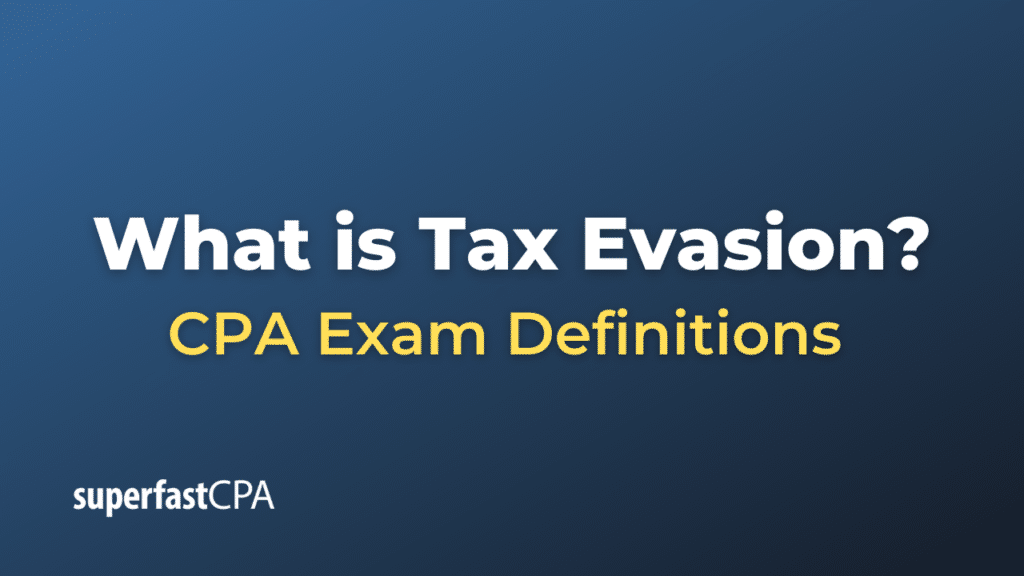Tax Evasion
Tax evasion is the illegal act of not paying taxes owed by intentionally underreporting income, inflating deductions, hiding money or assets, or using other deceitful methods. It involves deliberate acts to falsify tax returns or other documents to avoid tax liabilities. Tax evasion is a crime in almost all jurisdictions and can result in penalties, fines, interest charges, and even imprisonment.
Key points about tax evasion include:
- Intent: The critical distinction between tax evasion and other forms of non-compliance is the element of intent. Tax evasion involves willful actions to avoid paying taxes, not mere errors or honest mistakes.
- Methods: Some common tactics used in tax evasion include:
- Underreporting income or not reporting it at all.
- Claiming false or inflated deductions.
- Hiding or transferring assets or income.
- Keeping multiple sets of financial ledgers.
- Engaging in identity theft to file fraudulent tax returns.
- Using offshore accounts, shell companies, trusts, or other complex schemes to hide income or assets.
- Consequences: The penalties for tax evasion can be severe, depending on the jurisdiction and the nature and extent of the evasion. They can include:
- Significant fines.
- Payment of the tax owed plus interest.
- Imprisonment.
- Criminal charges and a potential criminal record.
- Damage to personal and professional reputation.
- Different from Tax Avoidance: It’s important to differentiate tax evasion from tax avoidance. Tax avoidance involves legally planning and organizing one’s affairs to minimize tax liabilities. While some aggressive tax avoidance schemes may be seen as abusive or questionable, they are fundamentally different from tax evasion, which is illegal.
- Reporting: Many countries have mechanisms for whistleblowers to report suspected tax evasion, offering protections and even rewards for individuals who provide information that leads to recovery.
Tax evasion undermines the revenue collection system, shifts the tax burden to honest taxpayers, and can destabilize economic systems. Authorities worldwide invest significant resources in detecting, penalizing, and preventing it.
Example of Tax Evasion
Let’s illustrate tax evasion with a hypothetical example:
Scenario:
John is a self-employed software consultant. Over the past year, he earned $120,000 in fees from various clients for his consulting services. However, instead of reporting his full income, John decided to omit $40,000 of his earnings on his tax return, declaring only $80,000 as his income.
In addition to this, John received a new laptop and smartphone for his work, costing him $2,500. However, on his tax return, he inflated the cost of these items to $5,000, aiming to increase his deductions and further decrease his taxable income.
Tax Evasion Tactics Used:
- Underreporting Income: By not declaring the full $120,000 he earned, John evaded taxes on the omitted $40,000.
- Inflating Deductions : By dishonestly increasing the cost of his business expenses, John further reduced his declared taxable income and the taxes he would owe.
Consequences:
A year later, the tax authority selected John’s return for a detailed audit. During the audit:
- They cross-referenced payments made to John by checking 1099 forms sent by John’s clients, revealing the additional $40,000 in income.
- They also asked for receipts for major expenses, where John failed to justify the $5,000 claim for his laptop and smartphone.
As a result:
- John had to pay the back taxes owed on the $40,000 unreported income and the inflated deductions.
- He was charged interest on the unpaid taxes.
- John was also fined a significant amount for willful evasion and for submitting a fraudulent tax return.
- The damage to his professional reputation made some clients wary of doing business with him in the future.
This example illustrates how a taxpayer can engage in deliberate actions to evade taxes and the potential risks and consequences that come with such behavior.










